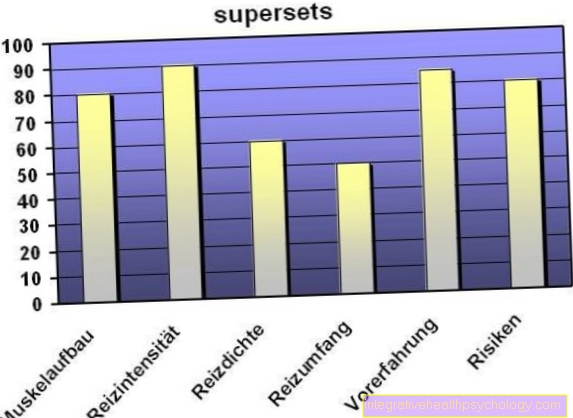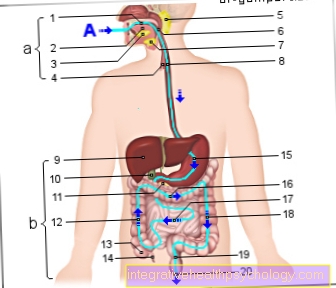Pancreatic enzymes
introduction
The pancreas produces a whole range of different enzymes for digesting carbohydrates, fats and proteins and releases them to the duodenum.
You can find detailed information about the pancreas here: Pancreas - Anatomy and Diseases

Which enzymes does the pancreas produce?
The first group of enzymes are the protein-splitting enzymes, also called proteases. These include:
- Trypsinogen
- Chymotrypsinogen
- and elastase.
The whole group of enzymes breaks down proteins from food into the smallest components, the amino acids. Some enzymes cut pieces at the end of the amino acid chain, other enzymes cut in the middle of the chain between the amino acids.
The second group of pancreatic enzymes are carbohydrate breakdown enzymes. These enzymes include the
- Alpha amylase
- and the ribonuclease.
These cut long carbohydrate chains, like in bread or pasta, into small sugar molecules so that these can be absorbed into the body.
The last group refers to the fat-splitting enzymes, to which pancreatic lipase belongs.
These three groups of enzymes cover all three main nutritional components fats, carbohydrates and proteins and are absolutely necessary for digestion.
In addition to enzymes, the pancreas also produces hormones such as insulin and glucagon, but these are released into the blood and not the intestines.
Here you can find more information about: Functions of the pancreas
Carbohydrate breakers
Alpha amylase
One of the pancreatic enzymes is alpha amylase. Alpha-amylases are an enzyme that break a certain bond in the starch and thus break down carbohydrates into small polysaccharides or double sugars.
Alpha-amylase is an endoamylase. Like scissors, it can cut through the middle of the molecular chain and not just cut off pieces from the end. This has the advantage that unassailable bonds in branched sugar chains can easily be bypassed. This is the main difference to the beta amylases, which can only cut at the ends of the chains. Amylases are produced in both the oral pancreas and the pancreas.
The short sugar chains produced by the amylase can be absorbed by the small intestine and used by the body, while long sugar chains cannot be used. Alpha-amylase shows the highest activity at a pH value in the neutral to alkaline range (pH value> 7). An increase in alpha-amylases in the blood is a laboratory parameter that serves as a warning sign of pancreatitis.
You can find a lot more information under our topic: Alpha amylase
Glucosidase
Glucosidase is a generic name that describes all enzymes that are responsible for breaking down sugar chains into individual sugar molecules. In humans, these are particularly located on the intestinal mucosa. Glucosidase inhibitors can be used as blood sugar-lowering drugs in type 2 diabetes mellitus.
Fat splitter
Lipase
After the lipase is released into the duodenum, it breaks down triacylglycerides from food. Lipase converts the triacylglycerols into individual fatty acids and glycerol. These individual parts can be absorbed and used by the intestine. The lipase is inactive without any help and needs auxiliary enzymes and calcium to break down the fats.
The auxiliary enzymes are also produced by the pancreas and activated in the intestine. A significant increase in serum lipase, i.e. lipase in the blood, is a marker for inflammation of the pancreas.
You might also be interested in:
- Lipase
- Lipase increased
The laboratory value should always be determined if there is a suspicion of pancreatitis, chronic pancreatitis or upper abdominal pain.
Serum lipase can also rise in other diseases, such as duodenal ulcer, intestinal obstruction or certain infectious diseases. However, this increase is not as extreme as with acute pancreatitis. The values can increase to eighty times the normal value.
Read more on the topic: Inflammation of the pancreas
Phospholipase A and B.
Phospholipases are also among the fat-splitting enzymes. They cut fatty acids from phospholipids. Phospholipids are complex fats that form an important part of cell membranes.
Phospholipase A separates the fatty acid residues from carbon atoms one and two. Phospholipase B can break down so-called ester bonds.
In addition to phospholipases A and B, there are also phospholipases C and D, but these belong to their own subgroup.
Cholesterol sterase
Cholesterol esterase is a hydrolytic (water-soluble) enzyme which, with the help of water, splits the ester bond between the carboxy group of an organic acid and the OH group of a choline. An important example of this class of enzymes is acetylcholinesterase. This splits the messenger substance acetylcholine into its components and recycles it in the nerve cells. Cholinesterases are mainly formed in the liver and are therefore also a signal for liver damage. They are suitable for permanent monitoring of existing liver diseases.
Read a lot more information on one Cholesterol sterase deficiency
Nucleic acid cleavers
Deoxyribonuclease and ribonuclease
The nucleic acid splitters deoxyribonucleases and ribonucleases are enzymes that can split DNA and RNA. Ribonuclease one occurs in humans. This is produced in the pancreas and breaks the ester bond between a phosphate group and a hydroxyl group.
Since all living beings, both plants and animals, store their genetic information in DNA and RNA, these structures are also in our food and have to be broken down by enzymes.
Protein splitter
Trypsin and chmotrypsin
Protein-splitting enzymes and their precursors are also produced in the pancreas. Proteins describe all food components that are made up of amino acids. The complete chains of amino acids cannot be used by the human body, the amino acids have to be cut apart. Trypsin is produced as a preliminary stage in the pancreas and is released together with an inhibitor to protect the pancreas. Trypsin is an enzyme that cuts particularly well behind basic amino acids.
In addition to its own activity, trypsin can also activate other enzymes. This also includes chymotrypsin, a serine protease that splits particularly aromatic amino acids. The precursor of chymotrypsin is also produced in the pancreas and only activated in the intestine.
An increased concentration of chymotrypsin in the stool can be an indication of diseases of the pancreas. Both trypsin and chymotrypsin have their pH optimum in the range seven to eight and thus in the slightly basic range.
Elastase
Another enzyme whose precursor is produced in the pancreas is elastase. The elastase is also activated by trypsin. It is a protein-splitting enzyme.
The pancreatic elastase is excreted unchanged with the stool after production and can therefore be used as a reliable marker for a disease or hypofunction of the pancreas. Increased elastase production can lead to lung damage.
Collagenase
Collagen is found in the connective tissue of many living things and can be broken down by collagenases. Collagenases are protein-splitting enzymes, so-called peptidases. In humans, most collagenases are metalloproteases.
These collagenases depend on certain metal ions in order to carry out their function. Some bacteria also have collagenases. In this way, for example, clostridia can destroy the connective tissue in the intestine.
If you have any further interest in this topic, then read our next article below: Collagenase
Kallikrein
Kallikrein is a serine protease and thus a protein-splitting enzyme that has many tasks in the body. There is a precursor of kallikrein in the blood and this has an influence on blood clotting. Kallikrein also has an impact on blood pressure and the body's water and salt balance. Kallikrein is also involved in inflammatory processes. The production takes place in the pancreas, the oral pancreas and the kidneys. About fifteen subtypes of kallikrein are known. Some of these sub-types can also be determined as tumor markers.
Carboxypeptidase
Carboxypeptidases are among the protein-splitting enzymes that are produced in the pancreas. Activation in the intestine occurs through the enzyme trypsin. After this activation, carboxypeptidases split off amino acids from the end of the amino acid chains in the food. Carboxypeptidase A splits the amino acid chain according to aromatic amino acids and carboxypeptidase B according to basic amino acids. Carboxypeptidases thus help to make the proteins in food usable for the body.
How can you stimulate the production of pancreatic enzymes?
The enzymes in the pancreas are subject to control loops made up of hormones and nerve stimuli in the body. Just thinking about food sets some of these control loops in motion and the production of digestive enzymes is increased.
The next stimulus is the stretching of the stomach in advance of the need to digest food. The main stimulating hormones are secretin and cholecystokinin. Secretin promotes the production of pancreatic juice and cholecystokinin promotes the secretion of enzymes. Control from the outside is hardly possible.
Read more on the topic: Function of the pancreas
How can pancreatic enzymes be increased?
Increased production of pancreatic enzymes can have many causes. A particularly large increase in the enzymes in the blood indicates an acute inflammation of the pancreas. Therefore, if the upper abdominal pain is unclear, these laboratory values should always be considered.
Another possible cause of increased values is the presence of a benign or malignant pancreatic tumor.
After a long-term inflammation of the pancreas, narrowed ducts can persist as a long-term consequence and thus continue to increase the pancreatic enzymes. Other serious diseases of the gastrointestinal tract can also increase these laboratory values. Which includes :
- Intestinal obstruction,
- Intestinal perforations
Certain drugs can also increase certain enzymes. Heparin, opiates, antibiotics and also the birth control pill all influence enzyme production. Changed laboratory values should always be discussed with the attending physician.
What can cause pancreatic enzymes to be low?
A reduced amount of pancreatic enzymes is equivalent to an underactive pancreas. Chronic inflammation of the pancreas can limit the ability to produce enzymes over a longer period of time. Malignant tumors in the pancreas can also weaken the function of the gland.
You might also be interested in: This is how you can recognize pancreatic cancer
Cystic fibrosis can be a genetic cause. Most commonly known as a lung disease, the disorder of the secretion composition also affects the pancreas. Such an under-function is often shown by digestive disorders. However, these symptoms usually only appear when the function of the pancreas falls below ten percent of its normal performance. The therapy is mostly limited to a special therapy.
Read more on the topic: Pancreatic insufficiency





























